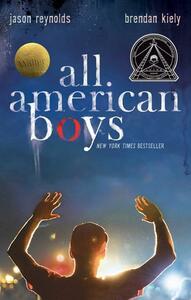Take a photo of a barcode or cover
As a white teacher with students of color in my classes, I have sought to learn how to be a better teacher to all my kids. Reading this book and experiencing the perspectives of the characters within is a tiny step in the right direction. Through All American Boys, I saw the inner lives of Rashad and his family before, during, and after his brutal beating. I saw the misconceptions that lead to the violence and later lies by his attacker, a police officer. I saw how people look at others and make judgements based on skin color, clothing, uniforms, preconceived notions. I also saw into the lives of his friends and classmates as they dealt with the aftermath. I saw how teachers were muzzled, coaches ignored the issues, parents on both sides try to protect their children. I love how literature and art were used to open people's eyes. The most compelling aspects of this story are the dynamic characters who are capable of seeing their own failings and changing their own attitudes. I want to be one of those people who can look at myself and see where I have messed up, then use that experience as a catalyst for positive change, for seeing the truth of what is happening around me, and standing up for my students. And that is the most important lesson I learned from this book. I have to make sure my students have space in which to be heard and valued.
The book is important, it really is...but. I didn't really care about Quinn. If he'd of just stuck his head in the sand and kept on living his life, it wouldn't have really changed the story for me. He just didn't matter, even though his people are major parts of the problem, I'm looking for books that focus on a shift amongst my people and our thoughts about our own worth. I mean, Rashad's dad just pissed me all the way off. This is a good book for people who think that love will fix everything, or that there are enough "unicorns" (this is what I call outliers in the world, you know, the "good" cops,"good" activist white folk, etc.) in the world for there to be this huge change in the way things are handled. Protesting will essentially change nothing. The revolution will involve major sacrifices and taking off our jobs for a day to lay down in the streets and recite the names of our fallen soldiers will not amount to much in the end; but hey, it's a start.
This book was recommeneded after watching a Ted Talk from an elementary school principal. He suggested teachers of all grades read this. I second that! Powerful, no matter who or where you may teach.
emotional
hopeful
informative
reflective
sad
tense
Plot or Character Driven:
A mix
Strong character development:
Yes
Loveable characters:
Yes
Diverse cast of characters:
Yes
A powerful take on a very real, serious, and present issue. Two teens, one black, one white, from the same high school but slightly different social circles, deal with the fallout from a moment that leads to police brutality. How does the victim cope and manage the reaction of family and friends in the face of accusations of wrongdoing? How does a witness to the violence cope with his connection to the aggressor and the feeling that it was all so very wrong when family and friends justify the actions as necessary to ensure safety… the alternating chapters with narration from each teenage young man, written by Jason Reynolds and Brendan Kiely put us in their circumstances to feel the pain, confusion, frustration, desperation, anger, and concern of lack of agency brought about by an afternoon trip to the neighborhood store. All too real. All too heartbreaking. All too inspiring to urge all readers to have the tough conversations and turn the questions inward: we know racism is very real and it exists in our communities… are we part of the problem and what can we do about it?
Unfortunately, because of reality, this book was excellent.
The violence in our country gave Jason Reynolds and Brendan Kiely lots to work with, sadly. This book was written in 2015 and although that was only 3 years ago, I don't think the scenarios are getting any better. When I read a book that falls into the realistic fiction category, that doesn't guarantee it will resonate with me at all. It all depends on what the books are about and what types of experiences I've had in my own life. As I read this book, though, I couldn't help but wonder if it's possible for someone to NOT relate in some way. Especially because Quinn tells some of the chapters, I think that everyone can relate to this topic.
I'm going to recommend this book to my students. It's a powerful read that they'll undoubtedly connect with, even in 2018.
The violence in our country gave Jason Reynolds and Brendan Kiely lots to work with, sadly. This book was written in 2015 and although that was only 3 years ago, I don't think the scenarios are getting any better. When I read a book that falls into the realistic fiction category, that doesn't guarantee it will resonate with me at all. It all depends on what the books are about and what types of experiences I've had in my own life. As I read this book, though, I couldn't help but wonder if it's possible for someone to NOT relate in some way. Especially because Quinn tells some of the chapters, I think that everyone can relate to this topic.
I'm going to recommend this book to my students. It's a powerful read that they'll undoubtedly connect with, even in 2018.
Originally, I was planning on reading The Perks of Being a Wallflower for the category “book set in high school” for my Reading Challenge. I kind of think that the reading gods knew that All American Boys was coming out in the fall of 2015 and had a different plan for me.
Every time Wallflower would come in at the library, I would be in the middle of a much larger book and couldn’t get to it. And that book is always on hold!
I still want to read Wallflower, but when I saw the article American Boys: A Young Adult Book About a Police Beating and a Hard Choice on NPR's website, I knew that I had found another high school book that would treat serious themes in YA fiction with honesty, integrity, and dignity.
The chapters alternate between Rashad, an ROTC artsy African-American student, and Quinn, a white basketball varsity player who’s hoping for a college scholarship.
The book covers the week in their lives following Rashad’s beating by a white police officer. Quinn witnessed the beating and said nothing. He knew the officer and didn’t know how to react.
What truly set this book on a pedestal for me was that co-authors Reynolds and Kiely wrote characters with every possible point of view on this assault, including how a viral video affected the media coverage.
And while every character espoused their opinion, one of the central questions the authors addressed was how much fathers shape their sons.
Rashad’s father was an ex-cop. Strict would be just one adjective to describe his parenting style. He did not approve of how Rashad or his older son appear. As the story developed, so did Rashad’s relationship with his father.
And then there’s Quinn. His father was killed in Afghanistan, and Paul, the white police officer, became a surrogate father to Quinn.
Each young man was navigating his own morality. As an English and social studies teacher, this book gives teens a chance to discuss institutional and systemic racism and stereotypes with a timely narrative. There was one teacher in the book who was characterized as the rigid institution of education. And sadly, I can attest that I often cannot discuss current events my students want to talk about. There’s no time. I have standards to teach and standardized tests to prepare for. I would hope that if Rashad and Quinn were students at my school that I would react differently to an attack so close to home, but I have not been put in that situation, so I truly don’t know how I would react.
For anyone concerned about the book’s mature themes, Reynolds and Kiely do offer an authentic picture of teen life for these two young men being raised in a small working class town. There’s language and alcohol use. Nothing sensationalist or overdone. But present. The description of the assault was disturbing to read as were some of the threats leveled against several people. Regardless, this book is an important read and a conversation starter.
While this book sometimes employed convenient details that made the plot feel less than complicated, the central theme offered enough complexity to keep me wondering how the boys would resolve their own questions. The resolution did not disappoint.
Every time Wallflower would come in at the library, I would be in the middle of a much larger book and couldn’t get to it. And that book is always on hold!
I still want to read Wallflower, but when I saw the article American Boys: A Young Adult Book About a Police Beating and a Hard Choice on NPR's website, I knew that I had found another high school book that would treat serious themes in YA fiction with honesty, integrity, and dignity.
The chapters alternate between Rashad, an ROTC artsy African-American student, and Quinn, a white basketball varsity player who’s hoping for a college scholarship.
The book covers the week in their lives following Rashad’s beating by a white police officer. Quinn witnessed the beating and said nothing. He knew the officer and didn’t know how to react.
What truly set this book on a pedestal for me was that co-authors Reynolds and Kiely wrote characters with every possible point of view on this assault, including how a viral video affected the media coverage.
And while every character espoused their opinion, one of the central questions the authors addressed was how much fathers shape their sons.
Rashad’s father was an ex-cop. Strict would be just one adjective to describe his parenting style. He did not approve of how Rashad or his older son appear. As the story developed, so did Rashad’s relationship with his father.
And then there’s Quinn. His father was killed in Afghanistan, and Paul, the white police officer, became a surrogate father to Quinn.
Each young man was navigating his own morality. As an English and social studies teacher, this book gives teens a chance to discuss institutional and systemic racism and stereotypes with a timely narrative. There was one teacher in the book who was characterized as the rigid institution of education. And sadly, I can attest that I often cannot discuss current events my students want to talk about. There’s no time. I have standards to teach and standardized tests to prepare for. I would hope that if Rashad and Quinn were students at my school that I would react differently to an attack so close to home, but I have not been put in that situation, so I truly don’t know how I would react.
For anyone concerned about the book’s mature themes, Reynolds and Kiely do offer an authentic picture of teen life for these two young men being raised in a small working class town. There’s language and alcohol use. Nothing sensationalist or overdone. But present. The description of the assault was disturbing to read as were some of the threats leveled against several people. Regardless, this book is an important read and a conversation starter.
While this book sometimes employed convenient details that made the plot feel less than complicated, the central theme offered enough complexity to keep me wondering how the boys would resolve their own questions. The resolution did not disappoint.
A bit heavy handed, but still powerful. While the internal monologues felt like an avenue for the author to preach rather than the characters actually having moments of self-discovery or epiphanies about the world, they still got the message across.
The story itself was somewhat narrowly focused, so there are a lot of loose ends, but I haven't read a story like this that focused so much on the witness/bystander and it was an interesting perspective to include.
Definitely seemed like a book geared AT high school students and not just about high school students like some other YA stories that deal with racism. Definitely recommend for a younger audience.
The story itself was somewhat narrowly focused, so there are a lot of loose ends, but I haven't read a story like this that focused so much on the witness/bystander and it was an interesting perspective to include.
Definitely seemed like a book geared AT high school students and not just about high school students like some other YA stories that deal with racism. Definitely recommend for a younger audience.



